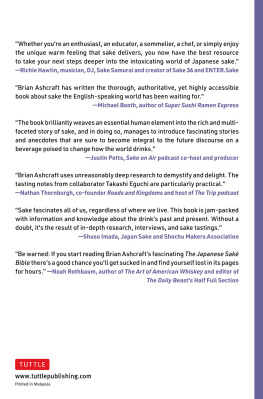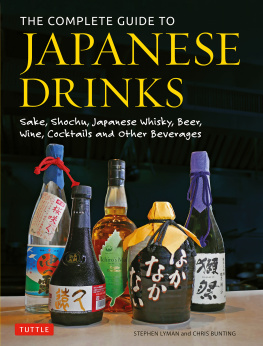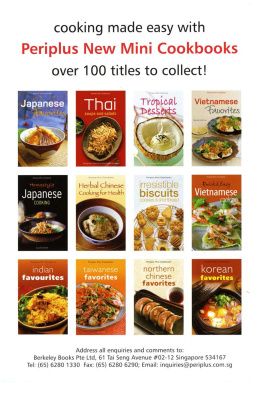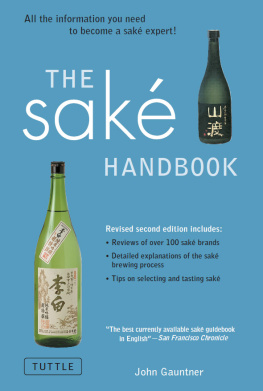
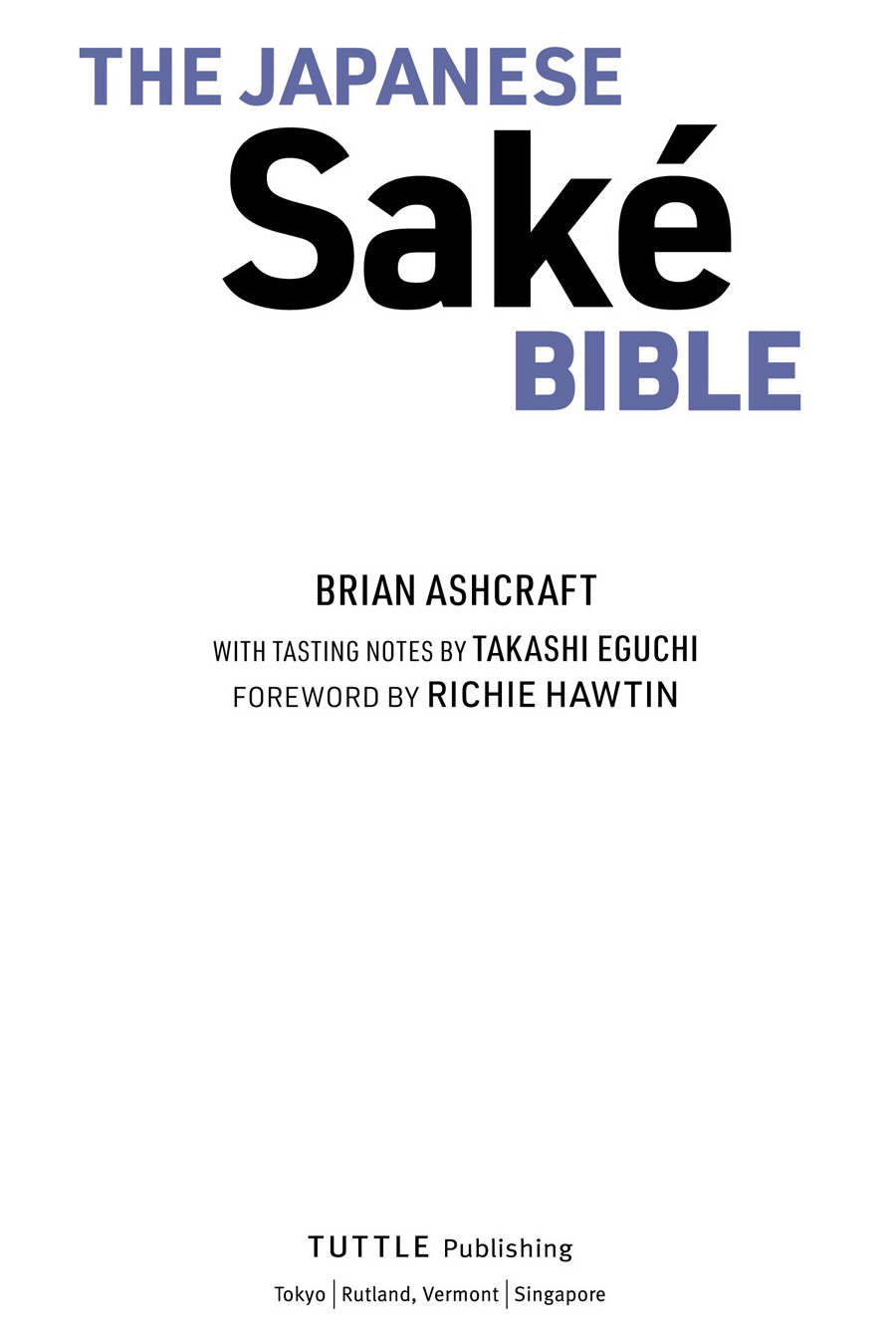
SHARING SAKE WITH THE WORLD
The Sake Bible launches at a crucial moment for sake as top chefs, sommeliers and enthusiasts alike are discovering this beautifully handcrafted beverage. Sake has been part of Japanese culture for over a thousand years and until recently you had to be an expert and make frequent visits to Japan to study and unravel the mysteries that are gathered together in this book.
As a longtime sake enthusiast, reading this book brings me back to my first trip to Japan. I soon realized that the sake I had tasted growing up in Canada had been very basic and rough. In Tokyo, strange oversized 1.8-liter (4-pint) isshobin bottles lined the windows and shelves of the local restaurants we visited, each decorated with beautiful labels covered with exotic motifs and unrecognizable characters. With every new bottle I realized no two sake were alike, discovering a surprising range of deep and refined flavors accompanied by fragrant aromas and subtle varying textures. Served in hand-crafted vessels, the sake gently supported the food, and the ritual of pouring for one another created a warm and communal feeling.
Those early experiences kindled my deep curiosity in sake, and as I returned to Japan each year for my DJ concerts, I visited breweries, talked with brewers, tasted local styles and learned as much about sake as I could. I started to fully appreciate the fine balance of tradition and modern technology that forms the basis of this refined, handcrafted and creative process.
As a musician who balances human intuition alongside electronic synthesizers and drum machines to write music, I found a wonderful parallel to the creative process of artisan sake. The attention to technical detail, the restricted ingredients and the astonishing resulting complexity, along with its heady intoxicating feeling, all reminded me of qualities that I strove to instill in my own productions. I was hooked, and just as I share my passion for music in my DJ performances, I set in motion a series of ideas that would allow me to spread my passion for sake to my fans and friends around the world.
This is where my intentions align with this books creators, in our mission to share our love and knowledge of Japanese sake with an international audience. In this book youll meet the men and women behind the sake: the families, brewery owners, master brewers and the staff, whose ingenuity, perseverance and dedication have continued the tradition and development of sake over generations. And you will learn how relatively simple ingredients become such a magic combination, creating the complexity and variety of flavors, textures and aromas that we all find so alluring in sake.
One of the most beautiful, and important, characteristics of sake is that it quietly enhances the flavors of food and actually pairs incredibly well with international cuisine. At tasting events around the world, I marry sake with regional specialties using local ingredients. From pasta and fresh cheeses in Italy, to seafood paella in Spain and delicate farm-to-table dishes at Michelin-starred restaurants, the versatility of sake is unparalleled and something I recommend everyone experiment with!
I remember one particular dinner in Lebanon where guests were astonished and excited how well this foreign beverage paired with their flavorful and hearty cuisine. In combination with the sake, they were tasting their favorite traditional dishes in a refreshing new light. Imagine a creamy lentil pasta with spicy tamarind and juicy pomegranate served with a silky junmai ginjo. Delicious!
Sake already finds itself on the beverage list of fine restaurants around the world and is appreciated by their most discerning customers. And with no additives, premium sake is a natural fit for todays health-conscious consumer. Sake really can be enjoyed everywhere and fits all social situations. Enjoy a rich junmai at your summer BBQ, sip a hearty genshu at a music festival, celebrate your birthday with a bottle of sparkling sake, or savor a delicate junmai daiginjo with your favorite dessert.
Whether youre an enthusiast, an educator, a sommelier, a chef or simply enjoy the unique, warm feeling that sake delivers, The Sake Bible will take you deeper into the intoxicating world of Japanese sake.
Richie Hawtin
Musician, DJ, Sake Samurai, and Sommelier
entersake.com/sake36.com

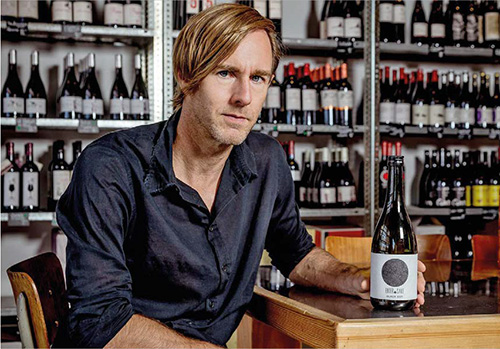
A WONDERFUL TIME TO BE A SAKE DRINKER
The morning sun shines on the waves in the harbor as seagulls wail. I look out across the bay to Hokkaido, where I spent time exploring Japans rich whisky tradition for my book Japanese Whisky. This pier in Aomori Prefecture is the farthest north Ive been on the main island of Honshu, where Ive lived since 2001. It was on this isle that sake as we know it was born.
Snow wont fall for a few weeks, but the brewing season is in full swing. Ive ridden train after train, all over Honshu, spending morning after morning in sake breweries and evenings with some of the best sake in Japanwhich is, of course, the best in the world.
I often think of the first time I stepped into a sake brewery. It was in 2005, on a crisp fall morning like this in Nara, Japans ancient capital. I remember the elegant fermented smells hitting my nose as I walked up the dirt road toward the white-walled brewery. I remember marveling that rice, water, yeast and the seemingly magical koji microorganisms could create one of the most amazing brews Id ever imbibed.
This is an interesting time for sake, even as number of breweries continues to decline. During the late 1800s there were 30,000 breweries in Japan, a number that was halved due to new taxes, increased national competition and brewery consolidation. During the 20th century, through the chaos of war and Japans economic miracle, that number continued to drop. There are currently some 1,500 sake breweries in Japan. Not all of those are operational, but the best put their own spin on a process that turns rice and water into ambrosia.
As the number of breweries dropped, so did sake sales. After a postWorld War II peak in 1975, sake consumption in Japan began to slide. In the Japanese liquor business, sakes prevalence has fallen from a dominant 80 percent during the preWorld War II years to less than 7 percent as of 2017. Beer, by comparison, accounts for around 32 percent of sales, and shochu approximately 10 percent. Liquor taxes, which were powered by sake sales and helped fund Japanese modernization and imperialism during the 20th century, comprised over 30 percent of the nations taxes in the early 1900s. In 2017, liquor taxes barely amounted to 2 percent, with sake outsold by shochu, liqueurs, and beer. Yet, according to the Japanese National Tax Agency, sake exports have increased from 1.8 million gallons in 2001 to 6.8 million gallons in 2018, with export sales up 113 percent from the previous year. That increase far surpasses those of Japanese beer, wine and whisky.
People around the world are starting to get into sake like never before, not only opening up new markets for Japanese sake but also giving rise to a new generation of breweries born on foreign soil. Best of all, brewers in Japan and abroad are making some delicious stuff. This is a great time to be a sake drinker. It couldnt happen to a better beverage.
Next page
